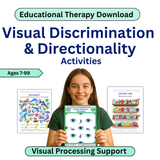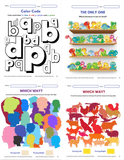Visual Processing Series | Discrimination & Directionality Workbook
Does your child or student struggle with confusing similar letters like b/d and p/q, have trouble telling left from right, or frequently mix up numbers and shapes? These common challenges can indicate weak visual discrimination and directionality skills, which are crucial for effective learning.
Introducing Visual Discrimination and Directionality Activities, a downloadable, engaging resource designed to strengthen these vital visual processing skills. Whether you’re a parent, teacher, therapist, or tutor, this comprehensive tool provides a fun and structured approach to improving visual recognition and spatial understanding.
What are Visual Discrimination and Directionality Skills?
- Visual Discrimination is the ability to spot differences between similar objects, such as letters, numbers, and shapes, which is essential for reading and math.
- Directionality refers to understanding spatial relationships, recognizing left from right, and identifying objects that are oriented in different directions.
Why Are These Skills Important?
Strong visual processing abilities are key to:
- Reading fluency: Quickly distinguishing between similar letters (like b/d or p/q) enhances word recognition and decoding skills.
- Math proficiency: Differentiating numbers and shapes is critical for solving problems and completing calculations.
- Following directions: Grasping spatial concepts like left and right is vital for understanding instructions, both in and out of the classroom.
What Makes This Resource Effective?
- 52 interactive activities: These exercises target both visual discrimination and directionality, making learning fun and effective.
- Gradual skill progression: The activities build in complexity, ensuring a steady improvement in visual processing skills.
- Flexible format: Ideal for classrooms, therapy sessions, or at-home learning, this resource can be completed on a computer, tablet, or by printing the worksheets.
Who Can Benefit from This Resource?
- Parents looking for tools to support their child’s learning at home.
- Teachers and tutors seeking engaging ways to enhance visual processing in students.
- Educational and occupational therapists working on visual-motor integration and spatial awareness.
- Vision therapists addressing issues related to eye-hand coordination and visual tracking.
Cognitive Skills Enhanced Through These Activities
In addition to improving visual discrimination and directionality, these activities help develop:
- Processing speed
- Visual sequencing
- Visual-spatial skills
- Visual form constancy
- Visual reasoning
- Executive functioning
- Attentional control
- Working memory
How to Use This Resource
- Digital completion: Use the activities on a computer or tablet for an easy, paperless option.
- Print and reuse: Place printed pages in dry-erase pockets for repeated practice.
- Traditional use: Simply print the worksheets in color and let students complete them as needed.
Invest in Visual Success Today!
Download Visual Discrimination and Directionality Activities today to give your student or child the tools they need to overcome visual processing challenges. Whether used for remediation or skill-building, this resource supports lifelong learning. Plus, its compatibility with computers and tablets makes it perfect for on-the-go education!
Watch confusion melt away as skills strengthen and confidence grows!
Double-click the video below to view some sample pages out of this publication:
What Other Areas of Cognition are Strengthened by Completing These Activities?
- Processing speed
- Visual sequencing
- Visual-spatial skills
- Visual form constancy
- Visual reasoning skills
- Executive functioning skills
- Attentional skills
- Working memory
How to Use This Publication:
- Complete these activities on a computer or tablet. See the image below to learn how.
- Purchase dry-erase pockets, print the activities in color, and let students practice the pages over and over again.
- Print the sheets in color and let your student(s) complete the pages.













